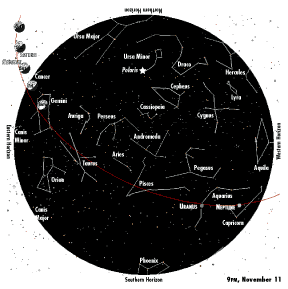 |
Sky Watch
by J. Alex Knoll
|
It’s a Great View from Here
But you may get a dizzy moving at a half-million miles an hour
The waning moon reaches last quarter Sunday and rises with Saturn at the magic hour of midnight between Sunday and Monday. Less than three degrees separate the two, and a third bright light, Regulus, the heart of Leo the lion, shines the same distance below the moon.
Each night the moon rises more than an hour later; six months ago the moon’s nightly appearance differed by just half that. Why the big change? Take a look at the moon high overhead, or look at the sky map. There’s simply more space to traverse at the middle of the celestial sphere than at the bottom or top. Yet it’s not like the moon speeds up to account for the greater journey. The moon’s speed across our sky is constant. Rather, the time of rise and set from night to night shifts proportionately to the moon’s place along the ecliptic.
The ecliptic is the imaginary path upon which travel the sun, moon, planets and even the constellations of the zodiac. It shifts season to season like a wobbling top, from more or less dead-center east-to-west during the equinoxes, to a far more pitched arc during the solstices. As we near winter solstice, the sun in the day dips ever lower while the moon at night climbs higher.
More than a path, the ecliptic is a phenomenon, one that illuminates the beauty and symmetry of the universe. Despite the three dimensions of space, celestial objects tend to align upon a plane. Earth’s rotation of 1,038 miles an hour creates a gravitational field that holds the moon in a fixed plane of orbit around us.
So too with the planets in our solar system, which are all held in a plane around the sun, spinning at 45,000 miles an hour. Even our solar system and others within the Milky Way are held in place by the gravity of the galaxy’s 500,000-mile-an-hour spin. And from here, we can watch it all pass by along the ecliptic highway.